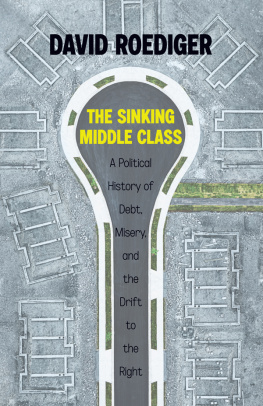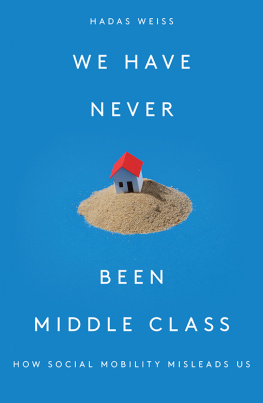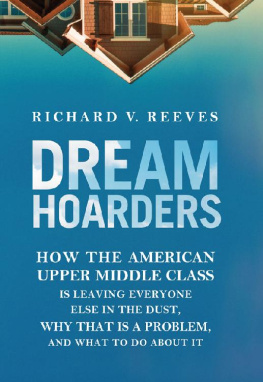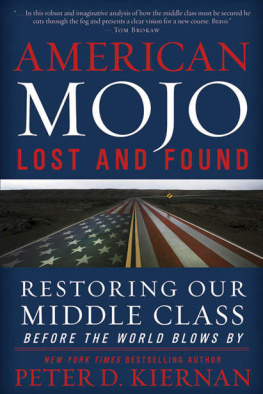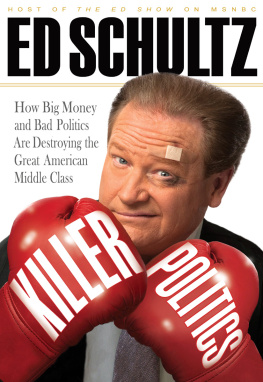THE AMERICAN MIDDLE CLASS
The middle class is often viewed as the heart of American society, the key to the countrys democracy and prosperity. Most Americans believe they belong to this group, and few politicians can hope to be elected without promising to serve the middle class. Yet today the American middle class is increasingly seen as under threat. In The American Middle Class: A Cultural History, Lawrence R. Samuel charts the rise and fall of this most definitive American population, from its triumphant emergence in the post-World War II years to the struggles of the present day.
Between the 1920s and the 1950s, powerful economic, social, and political factors worked together in the United States to forge what many historians consider to be the first genuine mass middle class in history. But from the cultural convulsions of the 1960s, to the stagflation of the 1970s, to Reaganomics in the 1980s, this segment of the population has been under severe stress. Drawing on a rich array of voices from the past half-century, The American Middle Class explores how the middle class, and ideas about it, has changed over time, including the distinct story of the black middle class. Placing the current crisis of the middle class in historical perspective, Samuel shows how the roots of middle-class troubles reach back to the cultural upheaval of the 1960s.
The American Middle Class takes a long look at how the middle class has been winnowed away and reveals how, even in the face of this erosion, the image of the enduring middle class remains the heart and soul of the United States.
Lawrence R. Samuel is the founder of Culture Planning, LLC, a consulting company offering cultural insight to Fortune 500 companies. He holds a Ph.D. in American Studies from the University of Minnesota, and was a Smithsonian Institution Fellow.
THE AMERICAN MIDDLE CLASS
A Cultural History
Lawrence R. Samuel
First published 2014
by Routledge
711 Third Avenue, New York, NY 10017
Simultaneously published in the UK
by Routledge
2 Park Square, Milton Park, Abingdon, Oxon OX14 4RN
Routledge is an imprint of the Taylor & Francis Group, an informa business
2014 Taylor & Francis
The right of Lawrence R. Samuel to be identified as author of this work has been asserted by him in accordance with sections 77 and 78 of the Copyright, Designs and Patents Act 1988.
All rights reserved. No part of this book may be reprinted or reproduced or utilised in any form or by any electronic, mechanical, or other means, now known or hereafter invented, including photocopying and recording, or in any information storage or retrieval system, without permission in writing from the publishers.
Trademark notice: Product or corporate names may be trademarks or registered trademarks, and are used only for identification and explanation without intent to infringe.
Library of Congress Cataloging in Publication Data
Samuel, Lawrence R.
The American middle class : a cultural history / Lawrence R. Samuel.
pages cm.
Includes bibliographical references and index.
1. Middle class--United States--History.
2. Middle class--Political activity--United States. 3. United States--Economic conditions--1945- 4. United States--Social conditions--1945- I. Title.
HT690.U6S26 2013
305.550973--dc23
2012049732
ISBN: 978-0-415-83186-4 (hbk)
ISBN: 978-0-415-83187-1 (pbk)
ISBN: 978-0-203-48166-0 (ebk)
Typeset in Bembo
by Taylor and Francis Books
Of the three classes, it is the middle that saves the country.
Euripides, c.420 B.C.
The most valuable class in any community is the middle class.
Walt Whitman, 1858
CONTENTS
At the end of World War II, when another generation of heroes returned home from combat, they built the strongest economy and middle class the world has ever known They understood they were part of something larger; that they were contributing to a story of success that every American had a chance to sharethe basic American promise that if you worked hard, you could do well enough to raise a family, own a home, send your kids to college, and put a little away for retirement. The defining issue of our time is how to keep that promise alive. No challenge is more urgent. No debate is more important. We can either settle for a country where a shrinking number of people do really well, while a growing number of Americans barely get by. Or we can restore an economy where everyone gets a fair shot, everyone does their fair share, and everyone plays by the same set of rules. Whats at stake are not Democratic values or Republican values, but American values. We have to reclaim them.
Excerpt from President Obamas 2012 State of the Union Address
It is not an exaggeration to say that most Americans, including the President of the United States, are thinking and talking a lot about the middle class these days. Indeed, the plight of the American middle classits dwindling numbers and loss of economic, social, and political poweris in fact one of the biggest stories of our time and place, but few people know how and why we got here. The American Middle Class places the current crisis of the middle class in much needed historical perspective, adding valuable context to what is arguably the most important issue in the national conversation. Knowing the backstory is essential for anyone claiming to be fluent in areas ranging from contemporary affairs to politics to economics. Tracing the cultural history of the idea of the American middle class over the last half-centuryits values, attitudes, and behavior, and role within society at a given timealso adds an important chapter to our understanding of the United States and its people, especially regarding the intersection between class and race.
A cultural history of the American middle class also plainly reveals that countless scholars, pundits, and journalists have weighed in on the subject over the decades, a fair reflection of its central role within the national discourse. Because the fate of the middle class carries such political weight in America, what these observers and advocates have said matters. Depending on how the middle class was defined, its fortunes were seen as rising or falling, the group seen as either unified or hopelessly divided. By focusing on rhetorical and ideological shifts in the arc of the American middle class rather than simply tracking relevant socio-economic developments, the main story becomes quite clear. A long view of the middle class reveals the long, painful slide of the group as the cultural tide began turning against it in the 1960s, a process showing few signs of reversing.
True to form, a cultural history of the American middle class leads us directly to important findings that challenge current thinking. The consensus among historians is that it was 1970s stagflation and 1980s Reaganomics that marked the dismantling of the American middle class, with tax policies favoring the rich creating a haves vs. have nots society. The plump economic mid-section became much skinnier in these decades, this thinking goes, as members of the middle class became either upwardly mobile (the haves) or downwardly mobile (the have nots). While this indeed took place, the roots of the shrinkage of the American middle class can be located a decade earlier. The fragmentation of the middle class was part of the larger splintering of American culture that began in the 1960s, I argue, an important idea that makes us rethink the causes of what was perhaps the beginning of the end of our global dominance. More powerful forces than simply the economy and politics were thus instrumental in triggering this major shift, in other words, factors that other (usually partisan) writers have ignored.



